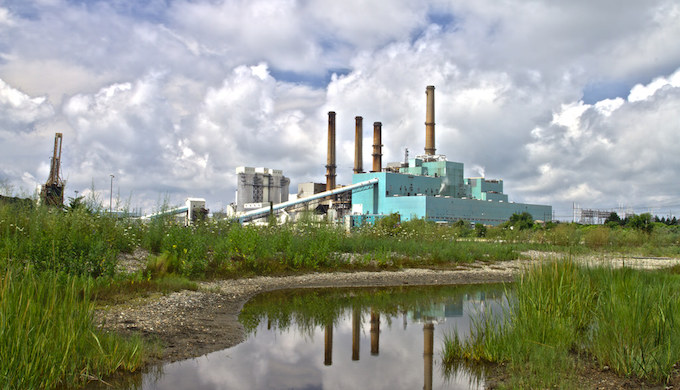Water scarcity has often impacted output in India’s power sector that depends overly on coal-fired plants requiring much cooling, but that can change with increasing use of renewable energy

Thermal power plants in India consume large amounts of scarce freshwater (Photo by Flickr)
Although India is facing a freshwater scarcity, it continues to depend heavily on electricity production that requires large amounts of water for washing of fuel and cooling, often leading to situations when production is affected at a time the government is aiming to provide energy access to all citizens.
There are more than 400 thermal power plants operating in the country and as many as 90% of them depend on freshwater for cooling, according to a new analysis by the World Resources Institute (WRI), an international non-profit working in the areas of environment and development.
The WRI report, titled Parched Power: Water Demands, Risks and Opportunities for India’s Power Sector, is the result of a quantitative analysis of the water use at India’s thermal power plants, which includes coal, solar thermal, geothermal, waste incineration, petroleum and a few natural gas power plants. Combining the findings with WRI’s Aqueduct water risk analysis, the researchers have found that nearly 40% of India’s freshwater-dependent thermal power plants experience high water stress.
“Water shortages shut down power plants across India every year,” O.P. Agarwal, CEO of WRI India, said in a statement. “When power plants rely on water sourced from scarce regions, they put electricity generation at risk and leave less water for cities, farms and families. Without urgent action, water will become a chokepoint for India’s power sector.”
Shutdowns due to water scarcity
The study found that there are shutdowns even in power plants located in regions that have no water scarcity, which included those at Farakka (West Bengal), Raichur (Karnataka), and Tiroda (Maharashtra). For instance, in March 2016, NTPC, India’s largest utility, completely halted production at its 2,100 MW Farakka power plant. See: Low water reserves spell trouble for India
The energy sector’s dependence on increasingly scarce water resources has serious consequences, according to the report that has just been released. Between 2013 and 2016, 14 of India’s 20 largest thermal utility companies experienced one or more shutdowns due to water shortages, it said. These cost utilities over INR 91 billion (USD 1.4 billion) in potential revenue from the sale of power.
This problem may worsen because the country’s thermal power sector is still expanding. The study says that by 2030, 70% of India’s thermal power plants are likely to experience increased competition for water from agriculture, industry and municipalities.
There are ways to resolve this issue, the report says, recommending the use of advanced cooling technologies, improving plant efficiency, and most importantly, moving increasingly towards renewable energy. India aims to generate as much as 40% of its electricity from renewable sources by 2030 under commitments made under the Paris climate agreement. If it is able to meet this target and improves efficiency at thermal plants, the power sector would save as much as 12.4 billion cubic metres of freshwater withdrawals every year, the study estimates. See: Renewables sprint ahead of Paris pledge
By prioritising solar photovoltaic (PV) and wind energy in areas of high water stress, India can boost its resilience, save water and reduce carbon emissions. “Renewable energy is a viable solution to India’s water-energy crisis,” said Deepak Krishnan, Manager of WRI India’s Energy Programme, and co-author of the report. “Solar PV and wind power can thrive in the same water-stressed areas where thermal plants struggle, so accelerating renewables can lower India’s water risk.”
“Our analysis shows that with implementation of mandated cooling technology changes and with the addition of renewable energy, particularly solar and wind, the withdrawal and consumption intensities (water withdrawn or consumed per MWh of electricity generated) comes down,” Krishnan told indiaclimatedialogue.net. “As far as absolute consumption is concerned, it depends on the trajectory India’s power sector takes. If we are able to scale up renewables, these numbers too will come down.”
For water consumption in the power sector to decline, state-owned utilities need to do a full assessment of their exposure to water-related risks, upgrade cooling technology and enhance power plant efficiency, Krishnan said. “The government also needs to step in to set up benchmarking guidelines on water dependence, exposure to water risks, and industry best practices for water management. A transparent mechanism to monitor the water withdrawal and consumption needs to be put in place,” he told indiaclimatedialogue.net. “Utilities also need to evaluate the economics of moving to advanced cooling technologies and, wherever possible (power plants located in a 50 km radius of municipal sewage treatment plants), should start swiftly implementing the tariff policy guidelines of 2016 that mandate use of treated sewage water.”
However, use of wastewater is easier to mandate than to implement. The ambitious plan to reduce the dependence of India’s coal-fired power plants on freshwater seems to have stalled in its starting blocks. The policy for some plants to use treated sewage water is impractical and economically non-viable, according to a recent report by Greenpeace India. See: Wastewater for thermal plants an impractical dream
